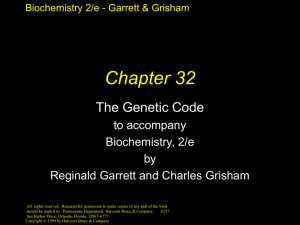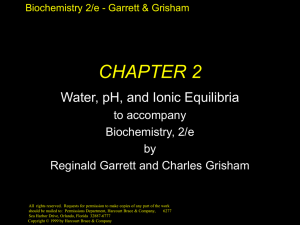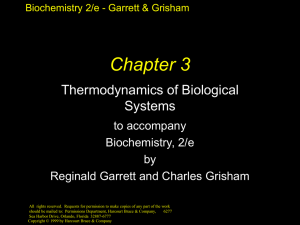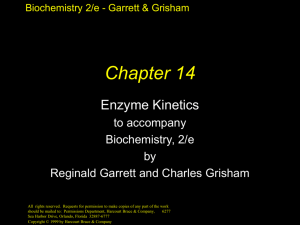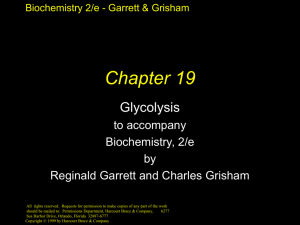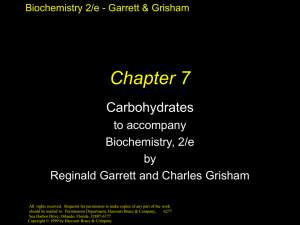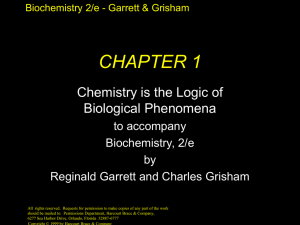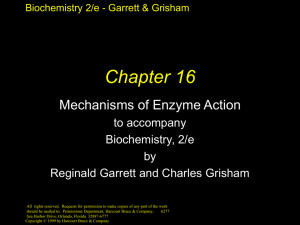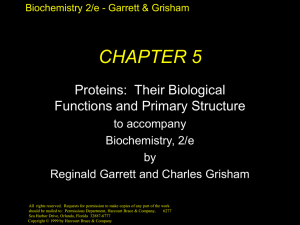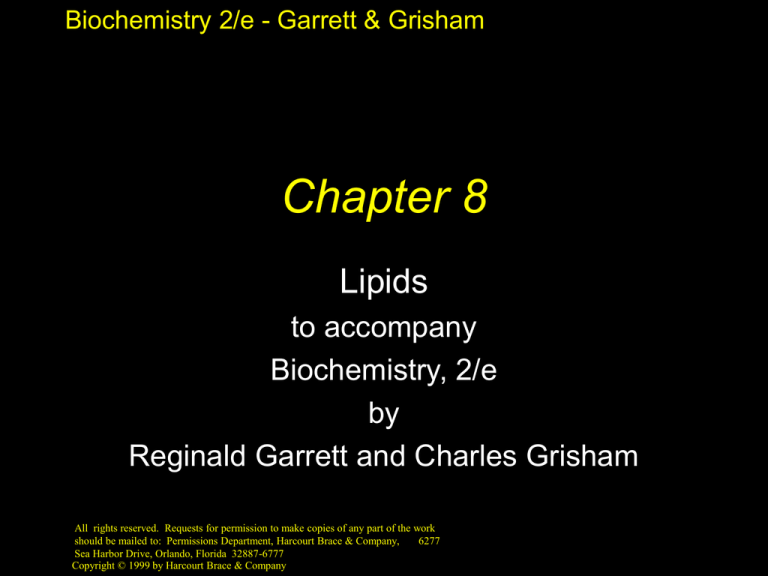
Biochemistry 2/e - Garrett & Grisham
Chapter 8
Lipids
to accompany
Biochemistry, 2/e
by
Reginald Garrett and Charles Grisham
All rights reserved. Requests for permission to make copies of any part of the work
should be mailed to: Permissions Department, Harcourt Brace & Company,
6277
Sea Harbor Drive, Orlando, Florida 32887-6777
Copyright © 1999 by Harcourt Brace & Company
Biochemistry 2/e - Garrett & Grisham
Outline
•
•
•
•
•
•
•
8.1 Fatty Acids
8.2 Triacylglycerols
8.3 Glycerophospholipids
8.4 Sphingolipids
8.5 Waxes
8.6 Terpenes
8.7 Steroids
Copyright © 1999 by Harcourt Brace & Company
Biochemistry 2/e - Garrett & Grisham
Classes of Lipids
•
•
•
•
•
•
All biological lipids are amphipathic
Fatty acids
Triacylglycerols
Glycerophospholipids
Sphingolipids
Waxes
Isoprene-based lipids (including steroids)
Copyright © 1999 by Harcourt Brace & Company
Biochemistry 2/e - Garrett & Grisham
8.1 Fatty acids
Know the common names and structures
for fatty acids up to 20 carbons long
• Saturated
– Lauric acid (12 C)
– Myristic acid (14 C)
– Palmitic acid (16 C)
– Stearic acid (18 C)
– Arachidic acid (20 C)
Copyright © 1999 by Harcourt Brace & Company
Biochemistry 2/e - Garrett & Grisham
Copyright © 1999 by Harcourt Brace & Company
Biochemistry 2/e - Garrett & Grisham
Fatty acids - II
• Unsaturated fatty acids
– Palmitoleic acid (16:1)
– Oleic acid (18:1)
– Linoleic acid (18:2)
– -Linolenic acid (18:3)
– -Linolenic acid (18:3)
– Arachidonic acid (20:4)
Copyright © 1999 by Harcourt Brace & Company
Biochemistry 2/e - Garrett & Grisham
Copyright © 1999 by Harcourt Brace & Company
Biochemistry 2/e - Garrett & Grisham
Fatty acids - III
Structural consequences of unsaturation
• Saturated chains pack tightly and form
more rigid, organized aggregates (i.e.,
membranes)
• Unsaturated chains bend and pack in a
less ordered way, with greater potential
for motion
Copyright © 1999 by Harcourt Brace & Company
Biochemistry 2/e - Garrett & Grisham
Copyright © 1999 by Harcourt Brace & Company
Biochemistry 2/e - Garrett & Grisham
8.2 Triacylglycerols
Also called triglycerides
• A major energy source for many
organisms
• Why?
– Most reduced form of carbon in nature
– No solvation needed
– Efficient packing
Copyright © 1999 by Harcourt Brace & Company
Biochemistry 2/e - Garrett & Grisham
Copyright © 1999 by Harcourt Brace & Company
Biochemistry 2/e - Garrett & Grisham
Triacylglycerols - II
Other advantages accrue to users of
triacylglycerols
• Insulation
• Energy without nitrogen
• Metabolic water
Copyright © 1999 by Harcourt Brace & Company
Biochemistry 2/e - Garrett & Grisham
8.3 Glycerophospholipids
Glycerophospholipids are phospholipids
but not necessarily vice versa
• Know the names and structures in
Figure 8.6
• Understand the prochirality of glycerol
• Remember that, if phospholipid contains
unsaturation, it is at the 2-position
Copyright © 1999 by Harcourt Brace & Company
Biochemistry 2/e - Garrett & Grisham
Copyright © 1999 by Harcourt Brace & Company
Biochemistry 2/e - Garrett & Grisham
Copyright © 1999 by Harcourt Brace & Company
Biochemistry 2/e - Garrett & Grisham
Copyright © 1999 by Harcourt Brace & Company
Biochemistry 2/e - Garrett & Grisham
Ether Glycerophospholipids
An ether instead of an acyl group at C-1
• See Figure 8.8
• Plasmalogens are ether
glycerophospholipids in which the alkyl
chain is unsaturated
Copyright © 1999 by Harcourt Brace & Company
Biochemistry 2/e - Garrett & Grisham
Copyright © 1999 by Harcourt Brace & Company
Biochemistry 2/e - Garrett & Grisham
Ether Glycerophospholipids
• Platelet activating factor (PAF) is an
ether glycerophospholipid
• PAF is a potent biochemical signal
molecule
• Note the short (acetate) fatty acyl chain
at the C-2 position in PAF
Copyright © 1999 by Harcourt Brace & Company
Biochemistry 2/e - Garrett & Grisham
Copyright © 1999 by Harcourt Brace & Company
Biochemistry 2/e - Garrett & Grisham
Copyright © 1999 by Harcourt Brace & Company
Biochemistry 2/e - Garrett & Grisham
8.4 Sphingolipids
Base structure is sphingosine
• Sphingosine is an 18-carbon amino
alcohol
• Ceramides are amide linkages of fatty
acids to the nitrogen of sphingosine
• Glycosphingolipids are ceramides with
one or more sugars in beta-glycosidic
linkage at the 1-hydroxyl group
Copyright © 1999 by Harcourt Brace & Company
Biochemistry 2/e - Garrett & Grisham
Copyright © 1999 by Harcourt Brace & Company
Biochemistry 2/e - Garrett & Grisham
8.4 Sphingolipids
• Glycosphingolipids with one sugar are
cerebrosides
• Gangliosides - ceramides with 3 or
more sugars, one of which is a sialic
acid
Copyright © 1999 by Harcourt Brace & Company
Biochemistry 2/e - Garrett & Grisham
Copyright © 1999 by Harcourt Brace & Company
Biochemistry 2/e - Garrett & Grisham
Copyright © 1999 by Harcourt Brace & Company
Biochemistry 2/e - Garrett & Grisham
Copyright © 1999 by Harcourt Brace & Company
Biochemistry 2/e - Garrett & Grisham
8.5 Waxes
•
•
•
•
Esters of long-chain alcohols with longchain fatty acids
Highly insoluble
Animal skin and fur are wax-coated
Leaves of many plants
Bird feathers
Copyright © 1999 by Harcourt Brace & Company
Biochemistry 2/e - Garrett & Grisham
Copyright © 1999 by Harcourt Brace & Company
Biochemistry 2/e - Garrett & Grisham
8.6 Terpenes
•
•
•
•
•
Based on the isoprene structure
Know nomenclature
Understand linkage modes (Figure 8.16)
See structures in Figure 8.17
All sterols (including cholesterol) are
terpene-based molecules
Steroid hormones are terpene-based
Copyright © 1999 by Harcourt Brace & Company
Biochemistry 2/e - Garrett & Grisham
Copyright © 1999 by Harcourt Brace & Company
Biochemistry 2/e - Garrett & Grisham
Copyright © 1999 by Harcourt Brace & Company
Biochemistry 2/e - Garrett & Grisham
Copyright © 1999 by Harcourt Brace & Company
Biochemistry 2/e - Garrett & Grisham
Copyright © 1999 by Harcourt Brace & Company
Biochemistry 2/e - Garrett & Grisham
8.7 Steroids
• Based on a core structure consisting of
three 6-membered rings and one 5membered ring, all fused together
• Cholesterol is the most common steroid
in animals and precursor for all other
steroids in animals
• Steroid hormones serve many functions
in animals - including salt balance,
metabolic function and sexual function
Copyright © 1999 by Harcourt Brace & Company
Biochemistry 2/e - Garrett & Grisham
Copyright © 1999 by Harcourt Brace & Company
Biochemistry 2/e - Garrett & Grisham
Copyright © 1999 by Harcourt Brace & Company
Biochemistry 2/e - Garrett & Grisham
Copyright © 1999 by Harcourt Brace & Company
Biochemistry 2/e - Garrett & Grisham
Copyright © 1999 by Harcourt Brace & Company

